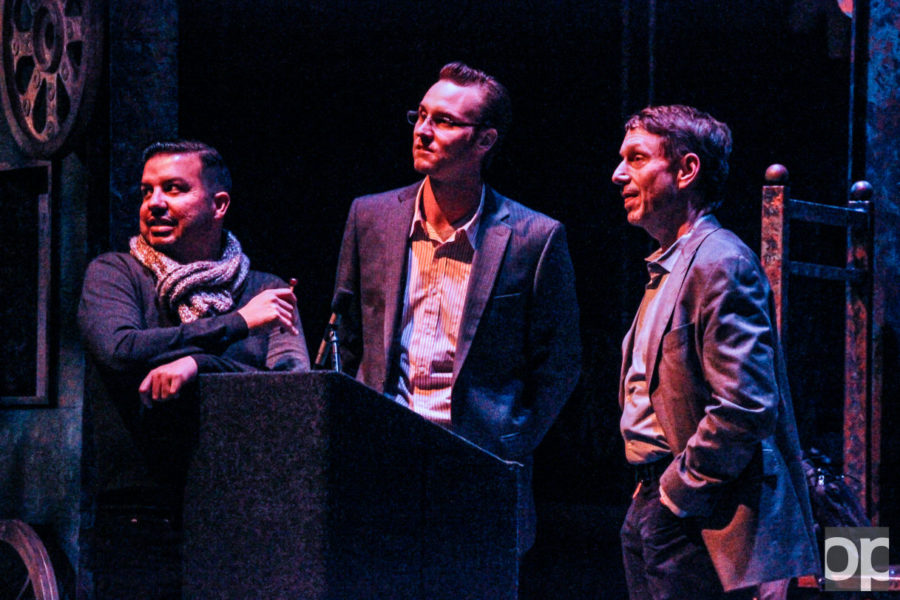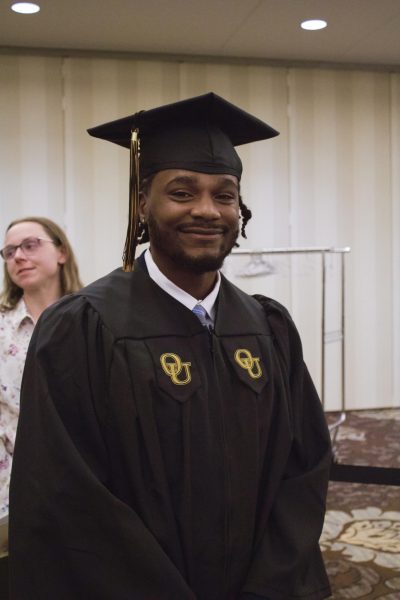James Elkins compares human and animal sight at Meadow Brook Theatre
Walking onto the Meadow Brook Theater stage wearing jeans, a sport jacket and tennis shoes, James Elkins said “We were having a great time rummaging around backstage.”
Elkins, a critic, historian, scholar and author of 20 books spanning a vast range of art-related subject matters, visited Oakland University Tuesday, Oct. 22 as part of the Visiting Artist and Scholar Lecture Series, sponsored by the Department of Art and Art History.
“We found goggles,” he said, and the crowd erupted with laughter. “There’s a balloon back there, it’s fabulous — great back there.”
Elkin’s humorous and light entrance onstage to present his lecture, “How to Use Your Eyes, How Some Animals Use Their Eyes,” set the tone for his perspective on the material.
“This is a very speculative lecture,” Elkins said. “There’s nothing here that you can’t argue with. It’s hypothetical.”
Elkins said that the whole idea for his lecture came as a response to criticism he received on his book, “How to Use Your Eyes,” and as a way to clarify the theories that he explored in his writing.
Elkins broke his lecture into two parts — how humans see and how animals see — going in depth about the science that makes the eye work and how the brains of animals and humans are wired to interpret the images brought in by their ocular devices.
Cody VanderKaay, assistant professor of art and director of studio art, said that the two portions of the lecture that Elkins brought to Oakland were part of a much larger presentation that, unfortunately, he was not able to present in full.
“We instinctively search for meaning, even when there is no return for this action,” Elkins said on how humans use their eyes.
He pulled up images of butterfly wings among his examples to illustrate how people innately see an “eye” on the wing of a Monarch butterfly, when really, there is a simple mathematical formula into which the composition of all butterfly wings fall.
We ascribe meaning to this simple, natural pigmentation, he suggested, and in doing that, we see what we want to see.
On the reverse, Elkins argued that there are some things that humans can’t see, no matter how hard they try. He cued up a photograph of a landscape.
Elkins explained a teaching exercise he does with his students at the School of the Art Institute of Chicago. He said he asked students to stare at the landscape for an amount of time, turn around, and draw what they saw.
The students would inevitably leave out lots of detail. Elkins explained that this happens for two reasons.
“Some things are too boring to see,” he said, “[and] some things are too complicated.”
“You never get a full or reasonably full picture or description of the thing you’re looking at,” he said. “Eighty percent of what the optic nerve passes to the visual cortex, or image processing portion of the brain, is not what you actually saw.”
Only 20 percent of what we “see” is actual, he said, and the brain compensates for the other 80 percent.
In speaking about the animal eye, Elkins went into detail in regards to how function affects structure. How an animal needs to use its eyes, he said, will drastically impact the build of that particular eye.
Elkins gave examples ranging from a slug, to a giant squid, to the camouflaging abilities of a flounder.
“Can animals help illustrate how strange seeing is?” Elkins said, exploring his idea that there are linkages between animal and human sight that will allow for greater understanding of how both work if cross-examined.
Standing to a round of applause, Elkins left the stage.
“[Elkins] is one of the most notable scholars that this series has sponsored,” VanderKaay said. “He’s nationally recognized … our university benefits from events like this.”








